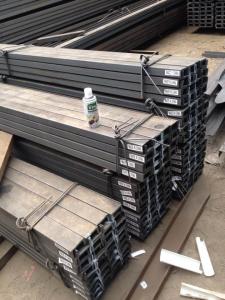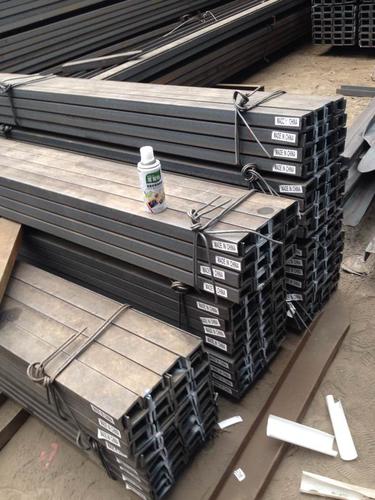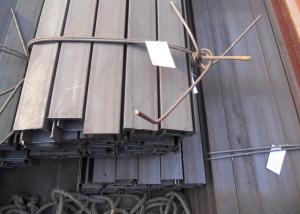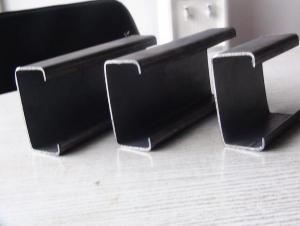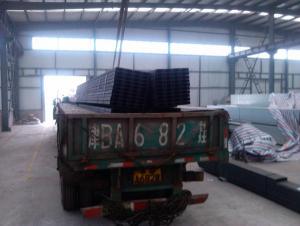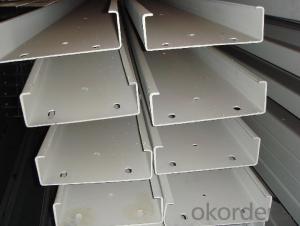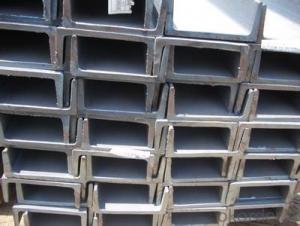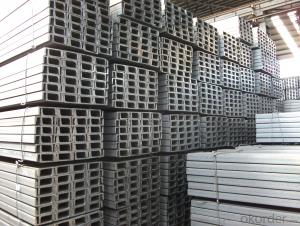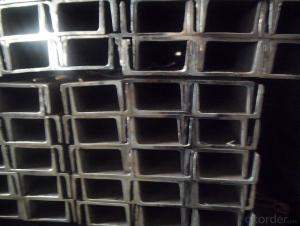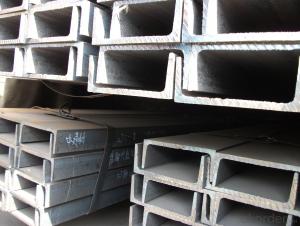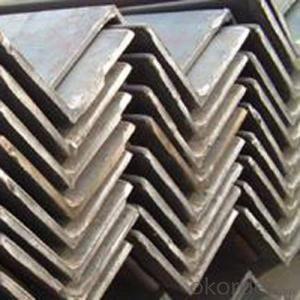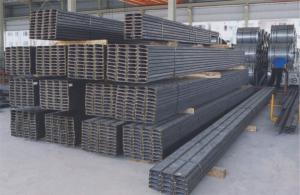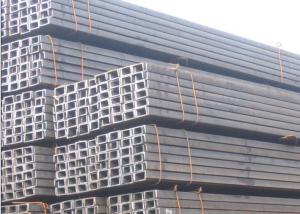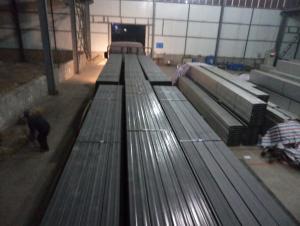Hot Rolled Steel Channel U Shape Section
- Loading Port:
- China Main Port
- Payment Terms:
- TT or LC
- Min Order Qty:
- 100 m.t.
- Supply Capability:
- 5000MT m.t./month
OKorder Service Pledge
OKorder Financial Service
You Might Also Like
Product Description:
OKorder is offering Hot Rolled Steel Channel U Shape Section at great prices with worldwide shipping. Our supplier is a world-class manufacturer of steel, with our products utilized the world over. OKorder annually supplies products to African, South American and Asian markets. We provide quotations within 24 hours of receiving an inquiry and guarantee competitive prices.
Product Applications:
Hot Rolled Steel Channel U Shape Section are ideal for structural applications and are used in main bearing structure, and they could be welded in order to support or hang a variety of facilities. They are also usually used in combination with I beam. The channel steel with sizes under 140mm is usually applied to construction engineering, as purline, while the channel steel with sizes above 160mm is more likely to be used in building vehicle chassis structure and mechanical structure. Furthermore, the channel steel in sizes above 300mm is target at building bridge structure, as tension bar.
Product Advantages:
OKorder's Hot Rolled Steel Channel U Shape Section are durable, strong, and wide variety of sizes.
Main Product Features:
· Premium quality
· Prompt delivery & seaworthy packing (30 days after receiving deposit)
· Can be recycled and reused
· Mill test certification
· Professional Service
· Competitive pricing
Product Specifications:
Manufacture: Hot rolled
Grade: Q195 – 235
Certificates: ISO, SGS, BV, CIQ
Length: 6m,12m, as per customer request
Packaging: Export packing, nude packing, bundled
| JIS STANDARD CHANNEL | ||||||
| SIZE(MM) | h(mm) | b(mm) | s(mm) | t(mm) | kg/m | length |
| 75X40x3.8x7 | 75 | 40 | 3.8 | 7 | 5.3 | 6m,12m |
| 75X40x5x7 | 75 | 40 | 5 | 7 | 6.92 | 6m,12m |
| 100X50x3.8x6 | 100 | 50 | 3.8 | 6 | 7.3 | 6m,12m |
| 100X50x5x7.5 | 100 | 50 | 5 | 7.5 | 9.36 | 6m,12m |
| 125X65x5.2x6.8 | 125 | 65 | 5.2 | 6.8 | 11.66 | 6m,12m |
| 125X65x6x8 | 125 | 65 | 6 | 8 | 13.4 | 6m,12m |
| 150x75x5.5x7.3 | 150 | 75 | 5.5 | 7.3 | 14.66 | 6m,12m |
| 150x75x6.5x10 | 150 | 75 | 6.5 | 10 | 18.6 | 6m,12m |
FAQ:
Q1: what is the difference between actual weight and theoretical weight?
A1: All the section steel has two weights: actual weight and theoretical weight. Actual weight is the weighing out when the product delivered from the mill. Theoretical weight is calculated by pieces. The invoice can be based on each of them as your request.
Q2: How many tons of steel products could be loaded in containers?
A2: Usually the steel products are delivered by bulk vessel because of the large quantity and the freight. However, there are no bulk vessel enter some seaports so that we have to deliver the cargo by containers. The 6m steel product can be loaded in 20FT container, but the quantity is changed according to the size, usually from 18tons to 25tons.
Q3: How soon can we receive the product after purchase?
A3: Within three days of placing an order, we will arrange production. The normal sizes with the normal grade can be produced within one month. The specific shipping date is dependent upon international and government factors, the delivery to international main port about 45-60days.
Images:
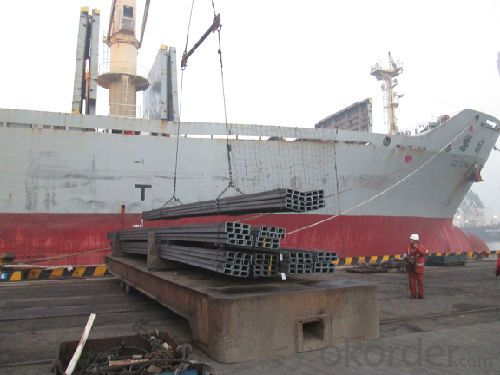

- Q: What are the different methods for protecting steel channels from fire?
- There are multiple options for safeguarding steel channels against fire. The objective of these techniques is to hinder or delay the spread of fire and maintain the structural integrity of the steel channels during a fire incident. 1. Intumescent Coatings: To safeguard steel channels from fire, one commonly used method is applying intumescent coatings. These coatings expand upon exposure to high temperatures, creating a protective char layer that insulates the steel and slows down the heat transfer. Consequently, this prevents the steel from reaching its critical temperature, thereby preserving its strength and stability. 2. Fireproofing Sprays: Another approach involves the application of fireproofing sprays on steel channels to establish a protective layer. These sprays comprise fire-resistant materials like gypsum or mineral wool, which offer insulation and delay the onset of steel heating. Fireproofing sprays are easily applicable in both industrial and commercial settings. 3. Fire-resistant Wraps: Fire-resistant wraps, made of materials such as fiberglass or ceramic fiber, constitute an alternative method for safeguarding steel channels from fire. These wraps are wrapped around the steel channels to provide insulation and prevent direct contact between the steel and the flames, thereby reducing the risk of structural failure. 4. Encasement with Concrete: In certain cases, steel channels can be encased in concrete to provide fire protection. Concrete acts as a barrier, preventing the steel from being exposed to high temperatures. This method is commonly employed in construction projects where fire resistance is of utmost importance. 5. Fire Barriers: Fire barriers serve as a means to compartmentalize the building and prevent the spread of fire around steel channels. Constructed using fire-resistant materials, these barriers can withstand high temperatures for a specific duration. The utilization of fire barriers assists in containing the fire and minimizing its impact on the steel channels. It is essential to consider various factors, including the required level of fire resistance, the nature of the building, and specific fire safety regulations, when selecting a fire protection method. Consulting with fire protection experts and adhering to local building codes and standards is crucial in determining the most appropriate method for protecting steel channels from fire.
- Q: What about channel 16?
- The specifications are expressed in millimeters of height (H) * leg width (b) * waist thickness (d), such as 100*48*5.3, which means waist height is 100 mm, leg width is 48 mm, waist thickness is 5.3 mm channel, or 10# channel steel. The same height of the channel, if there are several different leg width and waist thickness, also need to add a, B, C on the right side of the model to distinguish, such as 25#a, 25#b, 25#c and so on.
- Q: How do steel channels contribute to the overall thermal insulation of a structure?
- Steel channels do not directly contribute to the thermal insulation of a structure. However, they can be used as part of a system for installing insulation materials such as foam or fiberglass, which can effectively enhance the overall thermal insulation of the structure.
- Q: Are steel channels suitable for conveyor systems?
- Certainly, conveyor systems find steel channels to be a suitable option. The strength and durability of steel channels make them a popular choice in conveyor systems. They serve as a strong framework for supporting and guiding conveyor belts, ensuring the smooth and efficient movement of materials. Steel channels possess the capability to endure heavy loads and can be easily customized to meet specific requirements of conveyor systems. Furthermore, steel channels offer exceptional resistance to corrosion and wear, thus making them a dependable choice for conveyor systems in diverse industries, including manufacturing, mining, and logistics. In conclusion, due to their robustness and ability to withstand the demanding operational conditions of conveyor systems, steel channels are the preferred option.
- Q: How much is the load-bearing capacity of No. 10 I-beam per metre?
- National Standard No. 10 I-beam is 11.261kg/ meters; 6 meters long weight is 67.566kg
- Q: Can steel channels be used for conveyors?
- Certainly, conveyors can utilize steel channels. In conveyor systems, steel channels are usually employed to furnish structural reinforcement and steadfastness. They frequently serve as the backbone for the conveyor system, furnishing a robust foundation for other constituents like rollers, belts, and motors. Steel channels present exceptional strength, durability, and resilience to deterioration, rendering them appropriate for managing substantial loads and extended periods of operation. Furthermore, steel channels can be conveniently personalized and manufactured to accommodate precise conveyor needs, offering versatility in both design and installation.
- Q: What are the guidelines for steel channel installations in high-temperature environments?
- When it comes to installing steel channels in high-temperature environments, there are several guidelines that should be followed to ensure safety and optimal performance. These guidelines include: 1. Material Selection: Choose a steel channel that is specifically designed for high-temperature applications. The material should have high-temperature resistance, such as stainless steel, to prevent deformation or failure under extreme heat conditions. 2. Adequate Ventilation: Install steel channels in areas with proper ventilation to dissipate heat. This helps to prevent the accumulation of excessive heat, which can lead to structural damage or compromise the integrity of the installation. 3. Expansion Joints: Incorporate expansion joints in the steel channel system to allow for thermal expansion and contraction. High temperatures cause materials to expand, and without expansion joints, the steel channels may become stressed and potentially fail. 4. Proper Fixing and Support: Ensure that the steel channels are securely fixed and supported throughout the installation. This includes using appropriate brackets, fasteners, and supports that are capable of withstanding high temperatures. 5. Insulation: Consider using insulation materials to protect the steel channels from extreme heat and minimize heat transfer. Insulation can help maintain the structural integrity of the installation and prevent damage to surrounding components. 6. Regular Inspection and Maintenance: Regularly inspect the steel channel installation in high-temperature environments to identify any signs of damage, wear, or deformation. It is crucial to address any issues promptly to prevent potential failures or accidents. 7. Comply with Industry Standards: Adhere to relevant industry standards and regulations for steel channel installations in high-temperature environments. These standards provide specific guidelines and safety measures that should be followed to ensure a successful and safe installation. By following these guidelines, the installation of steel channels in high-temperature environments can be done with confidence, providing a durable and reliable solution for various applications.
- Q: How do steel channels resist corrosion?
- Steel channels resist corrosion due to the protective layer formed by the oxidation of iron when exposed to oxygen and moisture in the air. Additionally, steel channels can be galvanized or coated with a corrosion-resistant material, further enhancing their resistance to corrosion.
- Q: Can the bypass of the overhanging layer on the site be made of channel steel? How can I put the channel steel, if possible?
- The cantilever end of 6.10.7 steel cantilever beam shall be provided with a fixed point which can make the scaffold stand firmly with the steel beam. The location shall be no less than 100mm at the end of the cantilever beam. When the 6.10.8 anchor position is set on the floor slab, the thickness of the slab shall not be less than 120mm.
- Q: The role of channel?
- Channel steel is used in building construction and vehicle manufacture, including hot rolled channel steel and bent channel steel. Hot rolled channel steel can be divided into two types: ordinary and light. The channel steel specifications are from 5 to 40, i.e., the corresponding height is 5 to 40cm. At the same height, the light channel steel has narrower legs, thinner waist and lighter weight than ordinary channel steel. Channel steel is widely used in the manufacture of vehicles and various metal structures.
Send your message to us
Hot Rolled Steel Channel U Shape Section
- Loading Port:
- China Main Port
- Payment Terms:
- TT or LC
- Min Order Qty:
- 100 m.t.
- Supply Capability:
- 5000MT m.t./month
OKorder Service Pledge
OKorder Financial Service
Similar products
Hot products
Hot Searches
Related keywords
